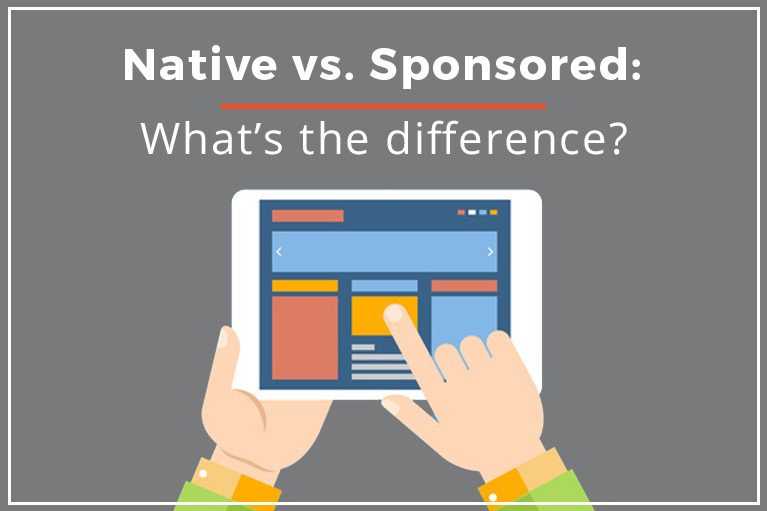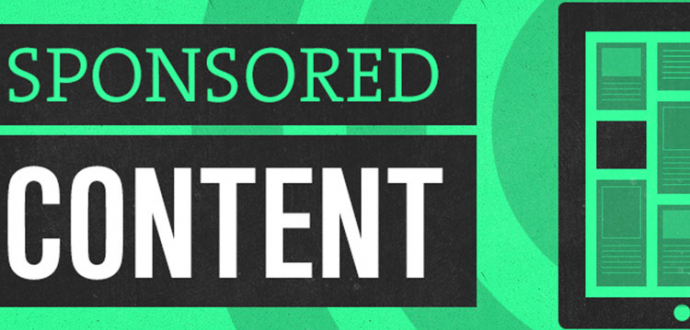During the dot-com boom and ecommerce explosion of the last couple decades, marketing groups began to realize the enormous power of all those eyes and ears plugged into the internet. Blocky banner ads and odd graphics began popping up around the tops, bottoms, and sides of favorite websites. But early online advertising wasn’t popular. It was annoying. People didn’t care. Depending on who you ask and where you google, you can find abysmal statistics on traditional online advertising results.
Sponsored Post
As a response to the huge potential of online advertising and the low conversion rate of traditional stuffing, the concept of a “sponsored post” crawled out from the binary cave it was sleeping in. A sponsored post is a piece of content, on a blog, website, or social media site, which is paid by a company in order to increase its brand or drive traffic to its own site. Sponsored posting allows companies to reach non-traditional audiences, or to reach traditional audiences in creative ways. Trying to sell fishing gear? Try posting content to a popular fishing blog. Want to start the next big makeup brand? Pay for airtime in YouTube channels and headlines in popular beauty blogs.
Sponsored posts are exclusive to the internet, or particularly new. Magazines would sometimes run stories or articles that would provide content with a marketing twist.
What is a Sponsored Post?
Sponsored Content Examples
Sponsored content is as wide as the kinds of regular content you can find in media outlets. Blogs can feature sponsored content in the form of articles that include affiliate links disguised through second-degree marketing. Instead of telling you to buy tea (first degree marketing), a blog article might tell you that tea is good for yoga and relaxing, and then might harmlessly mention a good tea brand (second degree marketing). YouTube videos and movies might feature sponsored content through product placement or product reviews. News sites might generate ad revenue through native advertising. Social media sites use sponsored content through influencer channels. Podcasts might do traditional ad reads, but also might produce an entire episode around a sponsored idea (movie release, app release, etc….). Sponsored content examples vary by the platform of distribution.
It isn’t always easy to tell what is a sponsored post and what isn’t. When sponsored content is done well, it tends to blend in. What is a sponsored post? What is a good sponsored post? The best sponsored content doesn’t blend in to fool you, it pitches you something relevant.
Sponsored Blog Posts
Blogs can’t just make money by just relentlessly throwing sponsored blog posts at the wall, assuming that something will stick. Good sponsored posts remain tapped into the brand of the blog and the brand of the company. What is a sponsored blog post that is good, engaging, and on brand? If you’re running a blog about soccer, you might take posts about the sport and the lifestyle of people who love the sport. Watches, water bottles, and technology might fit your niche. As-seen-on-TV home goods will probably not. Then again, if you’re running a home goods and lifestyle blog for moms, as-seen-on-TV home goods might get a personal spin from you to make them perfect for the blog. A good sponsored blog post example is a blog post that bridges the audience and brand in a natural way that benefits both audience and brand. Sell good things and people will trust you. Blogs are a great example of how sponsored posting doesn’t have to be trickery. If there’s a good blog you trust that connects you to a good product you love, then you don’t feel tricked or bamboozled.
Influencer Marketing
Influencers on Instagram--celebrity or quasi-celebrity users with high follower counts--can make six-figures per blog post, and influencer marketing is projected to be a 5 to 10 billion dollar industry in 2020. Influencers deliver sponsored ads by posting to social media accounts in ways that highlight a product or brand, thus delivering both high brand exposure to their millions of followers and giving the brand a signature bump by associating it with a trusted, beloved face.
Sites like this one let you use a sponsored post calculator to see how much money a celebrity might be expected to make per post. Note that often celebrities sign contracts with brands they love, allowing for greater earnings potential for the celebrity and greater image control for the brand. A sponsored post calculator is an algorithm which factors in a users follower count, engagement rate, likes per post, and comments per post.
What is Sponsored Content?

Native Advertising vs Sponsored Content
Native Advertising is a larger umbrella category for types of marketing which blend in with their environment. If you’re wading through an internet humor site and you see an ad for an investment firm, the contrast will be a bit jarring. The advertising, in this case, is not native. It stands out from its website. If you’re browsing the same internet humor site, and you see a post about “6 Hillarious Investment Mistakes,” well, we might be in native advertising land. You might click and read the whole post before realizing that a few of the links lead you to an investment site which is designed to help you avoid those hilarious investment mistakes. Native advertising not only uses similar content to the site it mirrors, but it also mocks up the form, voice, and style as well.
Native Advertising on News Sites
“Native Advertising” can technically mean any kind of content that is paid for by a brand or business and follows the form of the content on the host site, but generally speaking, when people use “native advertising,” they’re referring to sponsored news stories. Native Ads on news sites should rake in upwards of 20 billion by 2021, and will be featured by everyone from Buzzfeed to the New York Times and the Wall Street Journal. Repeated studies have shown that people can’t generally differentiate between native advertising and real news stories. The study found that youth and education levels strongly influenced the advertising distinguishing abilities of a person. Younger and higher educated people could generally spot native advertising easier than older and less educated people could.
Sponsored Content in Video and Audio
YouTube stars and Vlogs can receive payment to create sponsored video posts which reflect the tone and style of the channel. Sometimes the video is an explicit product review, mentioning that the person was paid, and sometimes the content is more subtle, merely featuring strongly in the title and premise and including links in the description. Sometimes the channels are influencers using their audience to pitch a relatable brand, similar to doing it on social media sites like Instagram and Snapchat. At other times, the channels are product reviewers who receive free products and kickbacks in order to provide an honest (but slightly pumped-up) review of the product.
The podcast medium looks like a bubble poised to burst or the next evolution of radio. Companies like Spotify are betting on the evolution of radio piece, though. Sponsored content on podcasts has been somewhat limited thus far, with most podcasts opting for a more traditional ad reads segment. However, many podcasters deliver the ads in a style and form similar to their show, which begins to border on sponsored content. Comedy podcasts are often given a bit of freedom to spice up the ad copy and sell it to their listeners in a familiar voice. As podcasts continue a meteoric media rise, we will probably begin to see more creative examples of sponsored content. Cold opens featuring new movies, entire episodes about companies, and discussions of new product releases will start to trickle out in greater numbers.
Sponsored Content Definition
Sponsored content is a category of marketing within native advertising. Sponsored content is “content” that originates from a sponsored source. While traditional advertising is copy written with explicit calls to action peppered throughout (“Buy our jeans! They’re cheap and comfortable!”), sponsored content is copy with more implicit calls to action (“Jeans are great for hiking and these jeans are great jeans.”). Sponsored content is usually second-degree marketing. Instead of asking a consumer to buy jeans, sponsored content might inform a consumer that jeans themselves are in style or that jeans are perfect for a summer night hike. From those conclusions, the sponsored content might move to recommend a particular brand of jeans. If you want to hike, then buy jeans, and if you want to buy jeans, then buy these jeans.
Conclusion
Sponsored posts are a type of native advertising content that creates bridges between audiences and brands through trusted sources. Those trusted sources might be the social media feed of an influencer or the homepage of a popular blog. Audiences and brands both win with sponsored posts. Brands engage critical masses of their target audience directly without scattering billboards and banner ads throughout the internet. Audiences get exposed to brands and products which might be a right fit for them and might improve their lifestyle. When sponsored posts are done right, it isn’t trickery or smoke and mirrors, it’s a mutually beneficial way of exposing brands and audiences to one another.
With the rise of targeted advertising and data-driven solutions on the internet, the utility of sponsored posts will waver a bit. Google and Amazon both have algorithms based on search history and personal data that help them deliver targeted ads which engage viewers in similar ways that sponsored posts are able to. However, sponsored posts will probably only increase, as consumers become more and more accepting of advertising that improves their lives with quality content and quality products. While “ads” were once synonymous with interruptions to television shows, public opinion on advertising is shifting as ads become more relational and less interruptive.


